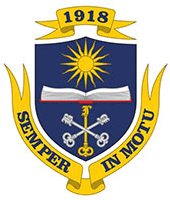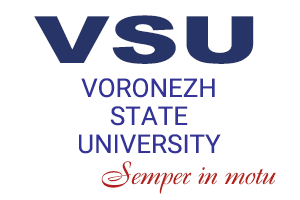Laboratories (Faculty of Physics)
- Laboratory of Telecommunication Systems and Electronic Warfare
- E.N. Ivanova Laboratory of Optical Spectroscopy
- Laboratory of Luminescence Spectroscopy
- Training Astronomical Observatory
- Joint Laboratory of Electron Structure of Condensed Matter of Voronezh State University and Kurnakov Institute of General and Inorganic Chemistry of the Russian Academy of Sciences
- Laboratory of Power Electronics
- Interdepartment Laboratory of Electronics and Photonics (section “Photonics”)
- Research and Training Laboratory of IC Design
- Laboratory of Functional Nanomaterials
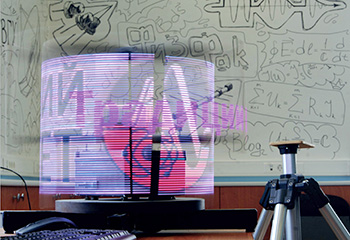 Laboratory of Telecommunication Systems and Electronic Warfare
Laboratory of Telecommunication Systems and Electronic Warfare
Industrial partners
- AO Concern Sozvezdiye
- Institute of Radio-engineering and Electronics of the Russian Academy of Sciences
Research area
Development of modern communication systems and solving the problems of electromagnetic compatibility
Laboratory equipment
Vectorscopes, spectrum analysers, super high frequency oscillographs, 3D printers, etc.
Available research methods
- Software systems for modelling of radio-engineering systems
- PXI NI-based computer-aided measurement methods
Challenges
To train highly qualified specialists for radioelectronic companies
Major projects
- Shield building digital communication systems
- Development of ultra-wideband antenna systems
- Fractal antennas
- Development of subnanosecond impulse generators
E.N. Ivanova Laboratory of Optical Spectroscopy
Research area
Atomic emission and molecular spectroscopy
Laboratory equipment
- IVS-29 activated AC arc and high voltage spark generator with high-frequency discharge ignition and voltage of approximately 30,000 V
- PGS-2 spectrometer with a plane diffraction grating and a ToshibaTCD1304AP series CCD
- Step attenuator
- Spectral atlases
- Vertex 37 series FT-IR spectrometer
Available research methods
- Qualitative, quantitative, and semiquantitative spectrum analysis
- FT-IR spectroscopy
Laboratory of Luminescence Spectroscopy
Research area
Luminescence and non-radiating processes in colloid quantum dots and their hybrid associates of molecules and aggregates of organic dyes
Laboratory equipment
- Computer-aided spectrometric system based on a MDR‑4 and MDR‑41 monochromator with a xenon 150 Watt light source used to study photoluminescence excitation spectra
- Vacuum optical cryostat based on a TMN‑200 turbomolecular pump
- OceanOptics fibre-optic spectrum system based on USB2000 spectrometer with a USB-DT light source used to study the adsorption and luminescence properties of colloid quantum dots
- Fully-automatic spectrofluorimeter based on a MDR‑23 monochromator and a R955P photomultiplier tube (Hamamatsu) in photon counting mode
- KLM‑650/80, KLM–H– 660–40–5, and KLM–G‑635–6–5 laser units
- Standa optical table Honeycomb Table Tops 1HT
- Highly sensitive IR luminescence detection system based on a PDF10C/M low-noise photodiodes (ThorlabsInc., USA)
Available research methods
Luminescence spectroscopy methods:
- Photoluminescence spectra in a temperature range of 77–350 К
- Luminescence excitation spectra
- Photostimulation spectra of the burst of luminescence
- Thermally-stimulated luminescence spectra
- Spectra of optical absorption and mirror reflection
Challenges
Spectral and luminescence properties of nanostructures, crystalline phosphorus, and organic molecules
Major projects
- Russian Foundation for Basic Research project No. 17–02–00748 а “Photophysical processes in rare-earth-ion-doped CdS and ZnS colloid quantum dots conjugated with organic molecules and J-aggregates”
- Russian Foundation for Basic Research project No. 7–72–10225 “Nonlinear media for low limiting optical threshold based on associates of Ag2S colloid quantum dots and dye molecules with controlled luminescence properties”
- Russian Foundation for Basic Research project No. 19–12–00266 “Managing photostability and quantum efficiency of IR luminescence of Ag2S colloid quantum dots for applications of quantum sensory studies”
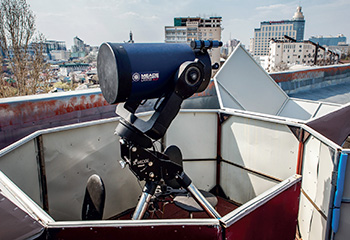 Training Astronomical Observatory
Training Astronomical Observatory
Industrial partners
- Sternberg Astronomical Institute
- Institute of Astronomy of the Russian Academy of Sciences
Research area
Solar system: observing events in the satellite system of Jupiter and Saturn
Laboratory equipment
- Meade lx200 - ACF telescope with a 35 cm diameter mirror, Cassegrain, with a corrected coma
- Three АТ‑1 astronomical tubes
- School refractor telescope
- School Mitsar reflector
Available research methods
- Visual
- Photographic
- Television observation methods
Challenges
- Organisation and conducting astronomical and astrophysical practice training for students
- Conducting educational lectures providing opportunities to visually observe astronomical objects
Major projects
The observatory is among the participants of the programme aimed at observing mutual occulations and eclipses in the satellite system of Jupiter and Saturn.
Joint Laboratory of Electron Structure of Condensed Matter of Voronezh State University and Kurnakov Institute of General and Inorganic Chemistry of the Russian Academy of Sciences
Industrial partners
- AO Voronezh Semiconductor Plant (Voronezh)
- AO VZPP-Mikron (Voronezh)
- National Research Centre “Kurchatov Institute” (Moscow)
- Lomonosov Moscow State Pedagogical University (Moscow)
- Udmurt Federal Research Centre of the Ural Division of the Russian Academy of Sciences (Izhevsk)
- Institute of Cell Biophysics of the Russian Academy of Sciences (Pushchino)
- Immanuel Kant Baltic Federal University (Kaliningrad)
- Helmholtz Zentrum Berlin (Berlin, Germany)
- Leibniz Institute of Photonic Technology (Jena, Germany)
- International Physics Centre (Donostia, Spain)
Research area
- Atomic and electron structure of condensed matter and nanostructures
- Electron spectroscopy and X-ray photoelectron spectroscopy and microscopy of functional nanomaterials
- Research using unique world-class megascience facilities
- Sorption and photoelectron processes in oxide semiconductors, gas sensors, resistance switching-memristor properties in oxide semiconductors
Laboratory equipment
- Exhaust carts, thermal, magnetron, and reactive sputtering units used to control formation of thin-film coatings
- Test benches for electrical parameters of materials and structures
- UV and visible region spectrometers
- Gas sensor test and measurement benches
- Electrophysical research and impedansometry units
- The laboratory uses РСМ-500 at the Department of Solid-State Physics and Nanostructures.
- The laboratory uses the output channel infrastructure of the sources of synchrotron radiation at the National Research Centre “Kurchatov Institute” (Moscow), BESSY II (Helmholtz Zentrum Berlin, Germany), SPring8 (Synchrotron Radiation Research Institute, Osaka, Japan), etc., including:
- High resolution photoelectron spectrometers
- Fluorescence detectors of the absorption spectroscopy of synchrotron radiation
- Systems for the detection of the quantum yield of absorption spectroscopy of synchrotron radiation
- Photoemission electron microscopes
- Glove box, ultra-high vacuum chambers for ex-situ and in-situ extra sample preparation and modification
Available research methods
- X-ray electron methods for the research of solid-state physics and nanostructures
- Spectroscopy of X‑ray absorption near edge structure, XANES
- Spectroscopy of fluorescence yield of X‑ray absorption near edge structure, FY XANES
- X‑ray photoelectron spectroscopy, XPS
- Photoemission electron microscopy, PEEM
- Ultra-soft X‑ray emission spectroscopy, USXES
- UV and visible region spectroscopy, volt-ampere and capacity-voltage characteristics of film materials, impedancemetry in the frequency range of 10–3–108 Hz
- Thermal and magnetron methods of formation of film samples
Challenges
- Using X-ray electron methods (XANES, XPS, PEEM, USXES, etc.), including complex research with application of unique world-class megascience facilities; optical and electrophysical research and diagnostics of a wide range of solids, nanostructures, functional and hybrid materials
- Synthesis of functional nanomaterials and formation of structures based on them, including nature-like technologies for organic and inorganic composite structures, as well as metallic, semiconductor, and dielectric systems
- Studying the structure, composition, physicochemical state of the surface and boundary lines of functional nanomaterials, structures, and elements of devices based on them
Major projects
- Russian Science Foundation project No. 19–72– 20180 “Compatibility and transformation of functional inorganic nanoparticles with cell cultures in hybrid material produced in vitro according to synchrotron studies of the reconstruction of atomic and electronic structure” (2019-2022)
- German Scientific Foundation (Deutsche Forschungsgemeinschaft) project “The study of the atomic and electronic structure of the surface of silicone-based nanostructures using X-ray and electronic spectroscopy with synchrotron radiation” (Untersuchungen der atomaren und elektronischen Oberflächenstruktur von nanostrukturierten Silizium-Oberflächen mit Synchrotron-Röntgenstrahlung) (2018-2019)
- Russian Science Foundation project No. 17–72–10287 “Atomic and electron structure of new functional composite nanostructures based on wide-band tin oxides and hybrid bionanomaterials combined with filamentary silicon” (2017-2019)
- The Government Order for Educational Institutions by the Ministry of Education and Science of the Russian Federation “Synthesising functional nanostructured materials and precision diagnostics for atomic and electronic structure and the interfacial interaction by means of synchrotron radiation of megascience facilities” (2017-2019)
- Federal Target Programme “Academic and Teaching Staff for Innovative Russia”, agreement No. 14.B37.21.1272 of 21.09.2012 “Atomic and electron structure and properties of various micro- and nanoforms of functional sensing materials” (2012-2014)
Laboratory of Power Electronics
Industrial partners
- OOO AEDON
- OOO KV-Sistemy
- OOO Special Power Supply Systems
Research area
- Power electronics
Laboratory equipment
- 10 computers
- 8 development kits with К1986ВЕ92QI microcontrollers
- Soldering equipment
- Measuring instruments
- Altium Designer CAE system
- Ansys software for the modelling of two dimensional and three dimensional electrical fields
- Laboratory on the premises of the Scientific Development and Production Centre with an access to facilities used to produce prototypes and to measure their characteristics
Challenges
- Calculation and design of transistor conversion units (voltage, power supplies, converters)
- Creating and testing prototypes
- Laboratory and small volume manufacturing
Available research methods
- Analytical calculations
- Calculation of losses
- Stabilisation and optimisation of dynamic characteristics
- Pspice computer modelling
- Selection and analysis of parameters for components base
- Studying prototypes
Interdepartment Laboratory of Electronics and Photonics (section “Photonics”)
Research area
- Nonlinear optical processes of dynamics of electronic excitation in nanomaterials
- Photoprocesses in quantum dots, including those conjugated with molecules and aggregates of organic dyes
Laboratory equipment
- Optical table
- Z-scan unit based on a motorised linear translator 8MT50- 200BS1-MEn1 (Standa, Lithuania) and Nd:YAG laser LS-2132UTF (Lotis TII, Belarus) generating radiation with wavelength of 266 nm, 355 nm, 532 nm, and 1,064 nm and duration of pulses of 5-8 ns, and a light detector FDS 10х10 (Thorlabs, USA)
- Pico Quant Time Harp 260 PicoSingle TCSPC system for time correlated photon counting to study luminescence decay dynamics within spectral range of 300-1700 nm provided by a MC-100- 20 photomultiplier tube (Becker&Hickle, Germany) and a single-photon detector InGaAs KIT-IF-25C (MicroPhotonDevices, Italy), together with semiconductor impulsed lasers PICOPOWER LD375 (wavelength of 375 nm, pulse duration of 60 ps) and PICOPOWER LD660 (wavelength of 660 nm, pulse duration of 50 ps) (Alphalas, Germany)
Available research methods
- Studying the nonlinear optical properties of materials by Z-scanning
- Time-resolved luminescence spectroscopy
Challenges
- Establishment of the type of nonlinearity (nonlinear absorption, absorption saturation, nonlinear refraction, nonlinear scattering) to measure the corresponding coefficients
- Analysis of nanosecond kinetics and photoluminescence lifetime in the spectral range of 300-1,700 nm
Major projects
- Russian Foundation for Basic Research project No. 17-52-12034 NNIO_a “Generation of the high harmonics using quantum dots” (Russia and Germany)
- Russian Science Foundation grant No. 17-72-10225 “Nonlinear media for low limiting optical threshold based on associates of Ag2S colloid quantum dots and dye molecules with controlled luminescence properties”
- Russian Foundation for Basic Research project No. 19–12–00266 “Managing photostability and quantum efficiency of IR luminescence of Ag2S colloid quantum dots for applications of quantum sensory studies”
Research and Training Laboratory of IC Design
Industrial partners
- AO PKK Milandr
Research area
Development of schematic-based designs in IC design, testing, and application
Laboratory equipment
- A hardware-software system NI Elvis II with LabView and Multisim software
- Microcontroller development kits K1986BE92QI
- Programmable logic device development kits Cyclone IV
- Digital oscilloscope
- Functional generators
- High-end server
Available research methods
- SPICE and Verilog computer modelling
- Automated and electrophysical measurements
Challenges
- Development of circuit designs of analogue units for microelectronic circuits
- Development of Verilog descriptions for analogue and digital units for microelectronic circuits
- Development of LabView-based measurement systems
- Development of ARM Cortex-M3 microcontroller-based embedded systems
- Development of test boards and conducting functional measurement of microelectronic circuits
- Development of human-computer interfaces (in cooperation with the Laboratory of Medical Cybernetics at the Faculty of Computer Sciences)
Major projects
- Grant of the Russian Foundation for Basic Research No. 16–29–08342 ofi_m “Comparative analysis of cognitive stimulation based on human-computer interfaces (including brain-computer interfaces) and its effects on healthy users and users with neurologic pathologies” (in cooperation with the Laboratory of Medical Cybernetics)”
- Grant of the Russian Foundation for Basic Research No. 17–29–02505 ofi_m “Molecular genetic features determining the effectiveness of eye tracking systems and brain-machine interfaces (in cooperation with the Laboratory of Medical Cybernetics)”
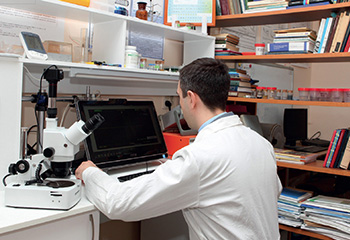 Laboratory of Functional Nanomaterials
Laboratory of Functional Nanomaterials
Industrial partners
- AO Voronezh Semiconductor Plant
- AO Research Institute of Electronic Technology
- NPO Energeticheskaya elektronika
Research area
Technology and study of functional properties of self-organising nanomaterials for electronics
Laboratory equipment
- Photocor Mini particle-size analyser
- Sonicator
- Bresser Advanse ID optical microscope with digital recording
- System for differential thermal analysis of microprocesses
- High precision laboratory balance
Available research methods
- Differential thermal analysis of processes in a drip reactor
- Particle size analysis by dynamic light scattering
- Surface morphological study in optical wavelengths
- Study of adsorption properties of materials
- Quantum-mechanical modelling of structure formation processes
- Computer modelling of processes of structure formation of functional nanomaterials
Challenges
- Synthesis and diagnostics of functional nanomaterials in a drip reactor
- System research of functional nanocomposites
- Experimental data processing and interpretation
- Preparing obtained results for publication
- Conducting research and development of projects within the laboratory specialisation
- Modelling structure formation processes
Major projects
Russian Science Foundation grant No. 16-43-360281 “Physical and chemical foundations of the low-temperature synthesis of silicon-carbide nanostructures for extreme electronic component base”
Voronezh State University • 1997–2025
